Portal:Food
F o o d
A portal dedicated to food and foodways
Introduction
.jpg)
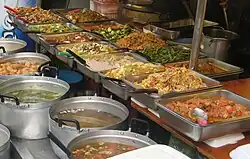
Food is any substance consumed by an organism for nutritional support. Food is usually of plant, animal, or fungal origin and contains essential nutrients such as carbohydrates, fats, proteins, vitamins, or minerals. The substance is ingested by an organism and assimilated by the organism's cells to provide energy, maintain life, or stimulate growth. Different species of animals have different feeding behaviours that satisfy the needs of their metabolisms and have evolved to fill a specific ecological niche within specific geographical contexts.
Omnivorous humans are highly adaptable and have adapted to obtaining food in many different ecosystems. Humans generally use cooking to prepare food for consumption. The majority of the food energy required is supplied by the industrial food industry, which produces food through intensive agriculture and distributes it through complex food processing and food distribution systems. This system of conventional agriculture relies heavily on fossil fuels, which means that the food and agricultural systems are one of the major contributors to climate change, accounting for as much as 37% of total greenhouse gas emissions. (Full article...)
Cooking, also known as cookery, is the art, science and craft of using heat to make food more palatable, digestible, nutritious, or safe. Cooking techniques and ingredients vary widely, from grilling food over an open fire, to using electric stoves, to baking in various types of ovens, to boiling and blanching in water, reflecting local conditions, techniques and traditions. Cooking is an aspect of all human societies and a cultural universal.
Preparing food with heat or fire is an activity unique to humans. Archeological evidence of cooking fires from at least 300,000 years ago exists, but some estimate that humans started cooking up to 2 million years ago.
The expansion of agriculture, commerce, trade, and transportation between civilizations in different regions offered cooks many new ingredients. New inventions and technologies, such as the invention of pottery for holding and boiling of water, expanded cooking techniques. Some modern cooks apply advanced scientific techniques to food preparation to further enhance the flavor of the dish served. (Full article...)
 Good article –
Good article –

Danish Bacon was a brand under which Danish bacon was sold in the United Kingdom. The product had "Danish" stamped on the rind between wavy lines. The Danish farmers producing Danish Bacon and their co-operatives were represented by Danske Slagterier, whose UK subsidiary was the Danish Bacon and Meat Council. Danske Slagterier was absorbed into a Danish agricultural umbrella organisation in 2009. The majority of Danish bacon is produced through the farmer-owned co-operative Danish Crown. The co-operative system has low costs because of the scale (25 million pigs per year) and the elimination of the need for markets. Most of the production is for export.
Danish pig exports started to the UK in the mid-19th century when exporting to Germany became difficult and have grown ever since despite attempts by UK domestic producers and other importers to compete. They have not been able to keep pace with Danish modernisation of the curing process and increasing centralisation. (Full article...)
Selected article –
Tofu (Japanese: 豆腐, Hepburn: Tōfu; Korean: 두부; RR: dubu, Chinese: 豆腐; pinyin: dòufu) or bean curd is a food prepared by coagulating soy milk and then pressing the resulting curds into solid white blocks of varying softness: silken, soft, firm, and extra (or super) firm. It originated in China and has been consumed in the country for over 2,000 years. Tofu is a traditional component of many East Asian and Southeast Asian cuisines; in modern Western cooking, it is often used as a meat substitute.
Nutritionally, tofu is low in calories, while containing a relatively large amount of protein. It is a high and reliable source of iron, and can have a high calcium or magnesium content depending on the coagulants (e.g. calcium chloride, calcium sulphate, magnesium sulphate) used in manufacturing. Cultivation of tofu, as a protein-rich food source, has one of the lowest needs for land use (1.3 m²/ 1000 kcal) and emits some of the lowest amount of greenhouse gas emissions (1.6 kg CO2/ 100 g protein). (Full article...)
Selected cuisine -

Historically, Korean cuisine has evolved through centuries of social and political change. Originating in ancient agricultural and nomadic traditions in southern Manchuria and the Korean Peninsula, it has gone through a complex interaction of the natural environment and different cultural trends. Rice dishes and kimchi are staple Korean foods. In a traditional meal, they accompany both side dishes (panch'an) and main courses like chuk (porridge), pulgogi (grilled meat) or myŏn (noodles). Soju liquor is the best-known traditional Korean spirit. (Full article...)
Selected ingredient –
Capparis spinosa, the caper bush, also called Flinders rose, is a perennial plant that bears rounded, fleshy leaves and large white to pinkish-white flowers.
The taxonomic status of the species is controversial and unsettled. Species within the genus Capparis are highly variable, and interspecific hybrids have been common throughout the evolutionary history of the genus. As a result, some authors have considered C. spinosa to be composed of multiple distinct species, others that the taxon is a single species with multiple varieties or subspecies, or that the taxon C. spinosa is a hybrid between C. orientalis and C. sicula. (Full article...)
Selected recipe –
Cornbread is a quick bread made with cornmeal, associated with the cuisine of the Southern United States, with origins in Native American cuisine. It is an example of batter bread. Dumplings and pancakes made with finely ground cornmeal are staple foods of the Hopi people in Arizona. The Hidatsa people of the Upper Midwest call baked cornbread naktsi, while the Choctaw people of the Southeast call it bvnaha. The Cherokee and Seneca tribes enrich the basic batter, adding chestnuts, sunflower seeds, apples, or berries, and sometimes combine it with beans or potatoes. Modern versions of cornbread are usually leavened by baking powder. (Full article...)
Sweet Cornbread is a variant of the Skillet Cornbread made throughout the Southern United States.
 Featured article –
Featured article –
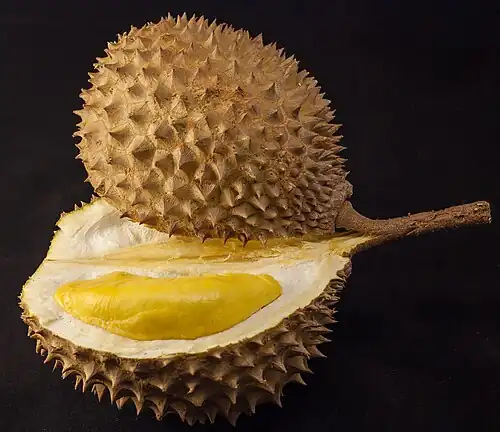
The durian (/ˈdʊəriən/ ⓘ) is the edible fruit of several tree species belonging to the genus Durio. There are 30 recognized species, at least nine of which produce edible fruit. Durio zibethinus, native to Borneo and Sumatra, is the only species available on the international market. It has over 300 named varieties in Thailand and over 200 in Malaysia as of 2021. Other species are sold in their local regions.
Known in some regions as the "king of fruits", the durian is distinctive for its large size, strong odour, and thorn-covered rind. The fruit can grow as large as 30 cm (12 in) long and 15 cm (6 in) in diameter, and it typically weighs 1 to 3 kg (2 to 7 lb). Its shape ranges from oblong to round, the colour of its husk from green to brown, and its flesh from pale yellow to red, depending on the species. (Full article...)
Selected image –
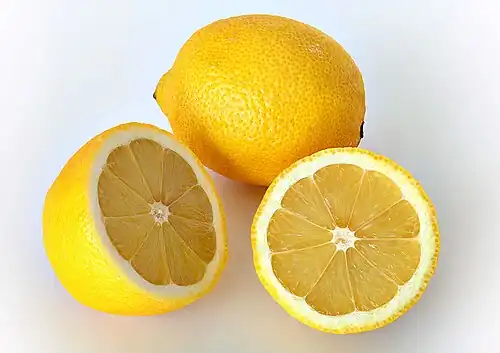
Selected biography –
B. April 24, 1914 – d. September 5, 2001
"Way back when I first started as a safety engineer, I took myself pretty seriously, and I found I was putting my audiences to sleep. So having lived all my life among the Cajuns of Louisiana, and having a good memory for the patois and the type of humor Cajuns go for, I started interspersing my talks on safety with Cajun humor."
Justin Elmer Wilson (April 24, 1914 – September 5, 2001) was a Southern American chef and humorist known for his brand of Cajun-inspired cuisine, humor and storytelling. (Full article...)
Did you know (auto-generated) –

- ... that agronomist Simon Groot was awarded the 2019 World Food Prize for "benefiting hundreds of millions of consumers with greater access to nutritious vegetables"?
- ... that the cuisine of Jerusalem reflects a blend of Jewish culinary traditions, including Sephardic, Kurdish, Ashkenazi, as well as Palestinian Arab traditions?
- ... that food stylist Susan Spungen estimated that she baked hundreds of pies with Josh Brolin and film staff while practicing for a scene in Labor Day?
- ... that environmental activist Nigel Savage created Hazon after googling "Jewish food movement" and receiving zero search results?
- ... that the Kitāb al-ṭabīẖ, a medieval Andalusian cookbook, contains an early version of Jewish challah bread, which traveled with Jews expelled from Spain and likely influenced Ashkenazi cuisine?
- ... that the Ni'isjoohl totem pole was once fed a diet of vacuum-packed food?
More did you know –
Related portals
Food topics
The following are topics relating to food
Categories
The following are categories relating to food.
![]()
Food list articles
- See also: Lists of foods and Category:Lists of drinks
The following are some Food list articles on Wikipedia:

- American cheeses
- Appellation d'Origine Contrôlée cheeses
- Apple cultivars
- Bacon dishes
- Bacon substitutes
- Basil cultivars
- Breads
- Breakfast beverages
- Breakfast cereals
- Breakfast foods
- British cheeses
- Cakes
- Candies
- Cheeses
- Cheese soups
- Christmas dishes (list)
- Cocktails
- Cookies
- Dishes using coconut milk
- Diets
- Doughnut varieties
- Egg dishes
- Fermented soy products
- Food additives
- Food additives (Codex Alimentarius)
- Foods named after people
- French cheeses
- French dishes
- Fried dough foods
- Fruits
- List of hamburgers
- Herbs and spices
- Hors d'oeuvre
- Indian dishes
- Indian snack foods
- Indonesian dishes
- Italian dishes
- Japanese snacks
- Japanese dishes
- Jewish dishes
- Kebabs
- Korean beverages
- Mango cultivars
- Moroccan dishes
- Pasta
- Pastries
- Philippine snack food
- Pies, tarts and flans
- Poppy seed pastries and dishes
- Potato dishes
- Puddings
- Raw fish dishes
- Rice dishes
- Rolled foods
- Sauces
- Seafood
- Seeds
- Sandwiches
- Snack foods
- Soft drinks by country
- Soul foods and dishes
- Soups
- Stews
- Street foods
- Tapas
- Turkish dishes
- Twice-baked foods
- Vegetable oils
- Vegetables
- Vodkas
Things you can do
 |
Here are some tasks awaiting attention:
|
Related WikiProjects
| Parent project: WikiProject Food and Drink | view |
| Child projects: | Task forces: (All inactive) |
|
|
| Related projects: | |
|
New articles
Rules | Match log | Results page (for watching) | Last updated: 2025-08-22 19:11 (UTC)
Note: The list display can now be customized by each user. See List display personalization for details.
- Pitaya (edit | talk | history | links | watch | logs | tools) by Wikiediter2029 (talk · contribs · new pages (1)) started on 2025-08-22, score: 20
- Jokūbas Mažionis (edit | talk | history | links | watch | logs | tools) by GiantSnowman (talk · contribs · new pages (28)) started on 2025-08-22, score: 10
- Crazy Nanny's (edit | talk | history | links | watch | logs | tools) by Caterpillar84 (talk · contribs · new pages (12)) started on 2025-08-22, score: 10
- Joel Peguero (edit | talk | history | links | watch | logs | tools) by Stonecold415 (talk · contribs · new pages (10)) started on 2025-08-21, score: 10
- Sweet Martha's Cookies (edit | talk | history | links | watch | logs | tools) by Darth Stabro (talk · contribs · new pages (12)) started on 2025-08-21, score: 10
- Podosphaera xanthii (edit | talk | history | links | watch | logs | tools) by Erysiphaceae (talk · contribs · new pages (1)) started on 2025-08-21, score: 10
- Chang Kyehyang (edit | talk | history | links | watch | logs | tools) by CountHacker (talk · contribs · new pages (60)) started on 2025-08-21, score: 10
- Sushi Express (edit | talk | history | links | watch | logs | tools) by Heeheemalu (talk · contribs · new pages (7)) started on 2025-08-21, score: 20
- Tom Tom (restaurant) (edit | talk | history | links | watch | logs | tools) by Another Believer (talk · contribs · new pages (81)) started on 2025-08-20, score: 10
- Jefferson dinner (edit | talk | history | links | watch | logs | tools) by Grbrumder (talk · contribs · new pages (1)) started on 2025-08-20, score: 10
- List of Minnesotan desserts (edit | talk | history | links | watch | logs | tools) by Kahlo157 (talk · contribs · new pages (4)) started on 2025-08-16, score: 10
- Campa (juice brand) (edit | talk | history | links | watch | logs | tools) by ShotaNino (talk · contribs · new pages (4)) started on 2025-08-20, score: 10
- Eléonore Vergeot (edit | talk | history | links | watch | logs | tools) by MayneAndRowan (talk · contribs · new pages (11)) started on 2025-08-20, score: 10
- Silingan Coffee (edit | talk | history | links | watch | logs | tools) by Bagoto (talk · contribs · new pages (3)) started on 2025-08-20, score: 10
- Yoga Bar (edit | talk | history | links | watch | logs | tools) by Kvinnen (talk · contribs · new pages (1)) started on 2025-08-20, score: 20
- Berkovitz v. United States (edit | talk | history | links | watch | logs | tools) by BD2412 (talk · contribs · new pages (115)) started on 2025-08-20, score: 10
- Smuggler's Cove (bar) (edit | talk | history | links | watch | logs | tools) by BanjoZebra (talk · contribs · new pages (14)) started on 2025-08-08, score: 20
- Nhoam svay (edit | talk | history | links | watch | logs | tools) by Turaids (talk · contribs · new pages (4)) started on 2025-08-19, score: 10
- Bassetts Ice Cream (edit | talk | history | links | watch | logs | tools) by Caterpillar84 (talk · contribs · new pages (12)) started on 2025-08-19, score: 10
- Agaricus crocodilinus (edit | talk | history | links | watch | logs | tools) by TheNatureKid (talk · contribs · new pages (2)) started on 2025-08-19, score: 10
- The Food Detectives (edit | talk | history | links | watch | logs | tools) by RandomMe98 (talk · contribs · new pages (22)) started on 2025-08-14, score: 20
- Coffee production in Madagascar (edit | talk | history | links | watch | logs | tools) by Folkezoft (talk · contribs · new pages (40)) started on 2025-08-18, score: 10
- Taka Cake House (edit | talk | history | links | watch | logs | tools) by Esther Siaw (talk · contribs · new pages (8)) started on 2025-08-18, score: 30
- Mita Cake House (edit | talk | history | links | watch | logs | tools) by Esther Siaw (talk · contribs · new pages (8)) started on 2025-08-18, score: 30
- Cavaretta's (edit | talk | history | links | watch | logs | tools) by Caterpillar84 (talk · contribs · new pages (12)) started on 2025-08-18, score: 20
- Jenni's Quesadillas (edit | talk | history | links | watch | logs | tools) by Tbhotch (talk · contribs · new pages (34)) started on 2025-08-17, score: 20
- Lindt Home of Chocolate (edit | talk | history | links | watch | logs | tools) by 95.98.65.177 (talk · contribs · new pages (8)) started on 2025-08-17, score: 30
- Acantharctus (edit | talk | history | links | watch | logs | tools) by 98.151.143.254 (talk · contribs · new pages (87)) started on 2025-08-17, score: 10
- Eugenie Kayitesi (edit | talk | history | links | watch | logs | tools) by Priestesspedia (talk · contribs · new pages (7)) started on 2025-08-17, score: 10
- Potamogeton cheesemanii (edit | talk | history | links | watch | logs | tools) by Richlitt (talk · contribs · new pages (20)) started on 2025-08-16, score: 10
- Loard's Ice Cream (edit | talk | history | links | watch | logs | tools) by Caterpillar84 (talk · contribs · new pages (12)) started on 2025-08-13, score: 10
- Chelarctus (edit | talk | history | links | watch | logs | tools) by 98.151.143.254 (talk · contribs · new pages (87)) started on 2025-08-17, score: 10
- Gay's Creamery (edit | talk | history | links | watch | logs | tools) by Rathfelder (talk · contribs · new pages (4)) started on 2025-08-17, score: 10
- Fred Peters (businessman) (edit | talk | history | links | watch | logs | tools) by ITBF (talk · contribs · new pages (3)) started on 2025-08-17, score: 10
- International Buy-A-Priest-A-Beer Day (edit | talk | history | links | watch | logs | tools) by Y.D.McGinty (talk · contribs · new pages (1)) started on 2025-08-16, score: 10
- Mumma (drink) (edit | talk | history | links | watch | logs | tools) by Nekros0day (talk · contribs · new pages (2)) started on 2025-08-15, score: 30
- Red Dog Blue Kat (edit | talk | history | links | watch | logs | tools) by HeleneM-Editor (talk · contribs · new pages (2)) started on 2025-08-13, score: 10
- Bob Seymour (baseball) (edit | talk | history | links | watch | logs | tools) by Yankees10 (talk · contribs · new pages (25)) started on 2025-08-16, score: 10
- Thrifty Ice Cream (edit | talk | history | links | watch | logs | tools) by 96.82.59.129 (talk · contribs · new pages (1)) started on 2025-08-16, score: 10
- Wafer paper (edit | talk | history | links | watch | logs | tools) by Chickenpox4dinner (talk · contribs · new pages (6)) started on 2025-08-16, score: 40
- Poke cake (edit | talk | history | links | watch | logs | tools) by AllWeKnowOfHeaven (talk · contribs · new pages (2)) started on 2025-08-16, score: 20
- Varieties of sambal (edit | talk | history | links | watch | logs | tools) by Native99girl (talk · contribs · new pages (1)) started on 2025-08-16, score: 40
- Amy Scherber (edit | talk | history | links | watch | logs | tools) by Thriley (talk · contribs · new pages (58)) started on 2025-08-15, score: 10
- International Beer & Beverage Industries (edit | talk | history | links | watch | logs | tools) by Kalatium (talk · contribs · new pages (6)) started on 2025-08-15, score: 20
- Bactronophorus (edit | talk | history | links | watch | logs | tools) by Wanwa (talk · contribs · new pages (5)) started on 2025-08-14, score: 10
- Downtown Olly's (edit | talk | history | links | watch | logs | tools) by Jinx williams (talk · contribs · new pages (1)) started on 2025-08-14, score: 20
- Fuzhu (food) (edit | talk | history | links | watch | logs | tools) by Unxed (talk · contribs · new pages (2)) started on 2025-08-14, score: 10
- A Little More (Ed Sheeran song) (edit | talk | history | links | watch | logs | tools) by Max24 (talk · contribs · new pages (2)) started on 2025-08-14, score: 10
- Ross Revillon Winans (edit | talk | history | links | watch | logs | tools) by GreenC (talk · contribs · new pages (29)) started on 2025-08-14, score: 10
- Cocoa production in the Democratic Republic of the Congo (edit | talk | history | links | watch | logs | tools) by Yue (talk · contribs · new pages (10)) started on 2025-08-14, score: 10
- Marios (cafe) (edit | talk | history | links | watch | logs | tools) by JunoRemus (talk · contribs · new pages (1)) started on 2025-08-13, score: 10
- Marios (Cafe) (edit | talk | history | links | watch | logs | tools) by JunoRemus (talk · contribs · new pages (1)) started on 2025-08-13, score: 10
- Maarouk (edit | talk | history | links | watch | logs | tools) by 2kbfloppadisk (talk · contribs · new pages (1)) started on 2025-08-12, score: 20
- Helado de paila (edit | talk | history | links | watch | logs | tools) by Bookworm-ce (talk · contribs · new pages (3)) started on 2025-08-12, score: 10
- Barbakan Delicatessen (edit | talk | history | links | watch | logs | tools) by Rathfelder (talk · contribs · new pages (4)) started on 2025-08-11, score: 20
- Kaffebrænderiet Merkur (edit | talk | history | links | watch | logs | tools) by Ramblersen2 (talk · contribs · new pages (29)) started on 2025-08-11, score: 10
- Panigacci (edit | talk | history | links | watch | logs | tools) by Superboilles (talk · contribs · new pages (1)) started on 2025-08-11, score: 10
- JJ Foodservice (company) (edit | talk | history | links | watch | logs | tools) by HMS Parliament (talk · contribs · new pages (1)) started on 2025-08-11, score: 20
- Pod 28 (edit | talk | history | links | watch | logs | tools) by Another Believer (talk · contribs · new pages (81)) started on 2025-08-07, score: 10
- Clinton Hall (restaurant) (edit | talk | history | links | watch | logs | tools) by Another Believer (talk · contribs · new pages (81)) started on 2025-08-11, score: 10
- Hypochilus xomote (edit | talk | history | links | watch | logs | tools) by Sarefo (talk · contribs · new pages (3)) started on 2025-08-11, score: 10
- Spondi (edit | talk | history | links | watch | logs | tools) by Expandinglight5 (talk · contribs · new pages (1)) started on 2025-08-10, score: 10
- The Organic Meat Company Limited (edit | talk | history | links | watch | logs | tools) by QINGSHAN XUE (talk · contribs · new pages (7)) started on 2025-08-08, score: 30
- Einspänner (edit | talk | history | links | watch | logs | tools) by Pineapple fez (talk · contribs · new pages (1)) started on 2025-08-10, score: 20
- Moong dal halwa (edit | talk | history | links | watch | logs | tools) by BuySomeApples (talk · contribs · new pages (4)) started on 2025-08-10, score: 20
- Larry's Produce (edit | talk | history | links | watch | logs | tools) by Caterpillar84 (talk · contribs · new pages (12)) started on 2025-08-10, score: 10
- Erbswurst (edit | talk | history | links | watch | logs | tools) by Mbdfar (talk · contribs · new pages (10)) started on 2025-08-10, score: 10
- Kondreh (food) (edit | talk | history | links | watch | logs | tools) by Pierre Bon-Bon (talk · contribs · new pages (1)) started on 2025-08-09, score: 20
- Dayne's Craft Barbecue (edit | talk | history | links | watch | logs | tools) by Horse Eye's Back (talk · contribs · new pages (19)) started on 2025-08-09, score: 10
- Seattle Coffee Company (edit | talk | history | links | watch | logs | tools) by Husskeyy (talk · contribs · new pages (7)) started on 2025-08-09, score: 30
- E. Waldo Ward & Son (edit | talk | history | links | watch | logs | tools) by Caterpillar84 (talk · contribs · new pages (12)) started on 2025-08-09, score: 40
- Jhonny Fernández (edit | talk | history | links | watch | logs | tools) by Cilidus (talk · contribs · new pages (190)) started on 2025-08-09, score: 10
- Tristan Peters (edit | talk | history | links | watch | logs | tools) by Canuck85 (talk · contribs · new pages (5)) started on 2025-08-08, score: 10
- Kim Ja-rim (edit | talk | history | links | watch | logs | tools) by James Hyett (talk · contribs · new pages (1)) started on 2025-08-08, score: 10
- Bakehouse (bakery) (edit | talk | history | links | watch | logs | tools) by ManducatingMouser (talk · contribs · new pages (1)) started on 2025-08-08, score: 20
- Pelman v. McDonald's Corporation (edit | talk | history | links | watch | logs | tools) by Heroeswithmetaphors (talk · contribs · new pages (15)) started on 2025-08-08, score: 10
- Fat Kid Food Co. (edit | talk | history | links | watch | logs | tools) by Another Believer (talk · contribs · new pages (81)) started on 2025-08-08, score: 10
- Trump Burger (edit | talk | history | links | watch | logs | tools) by Another Believer (talk · contribs · new pages (81)) started on 2025-08-08, score: 10
- Feinkost Käfer (edit | talk | history | links | watch | logs | tools) by Global Donald (talk · contribs · new pages (16)) started on 2025-08-08, score: 10
Associated Wikimedia
The following Wikimedia Foundation sister projects provide more on this subject:
-
Commons
Free media repository -
Wikibooks
Free textbooks and manuals -
Wikidata
Free knowledge base -
Wikinews
Free-content news -
Wikiquote
Collection of quotations -
Wikisource
Free-content library -
Wikiversity
Free learning tools -
Wiktionary
Dictionary and thesaurus
Sources
More portals
-
 List of all portals
List of all portals -

-

-

-

-

-

-

-

-

-
 Random portal
Random portal -
 WikiProject Portals
WikiProject Portals
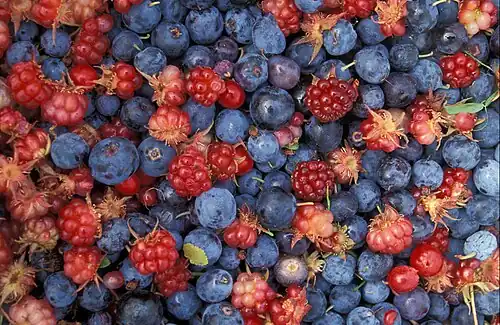
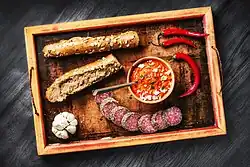




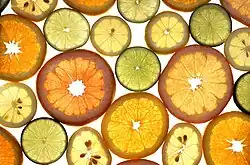
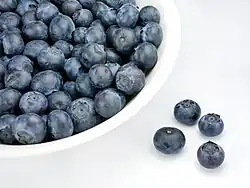





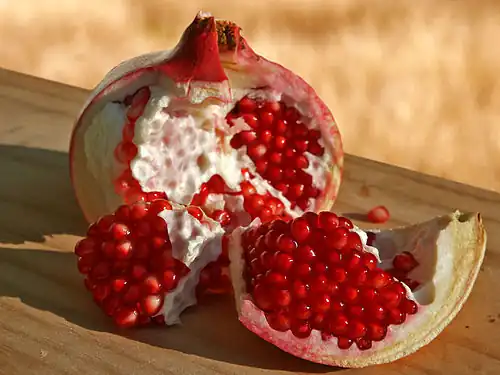
.jpg)

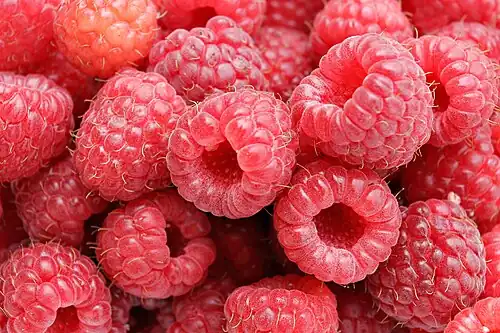


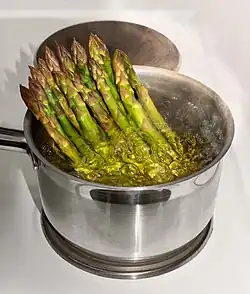

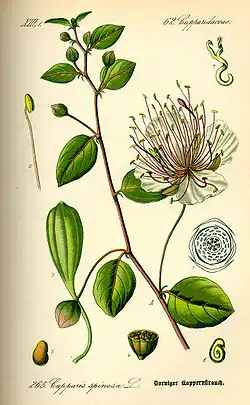
.jpg)







